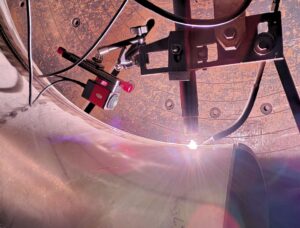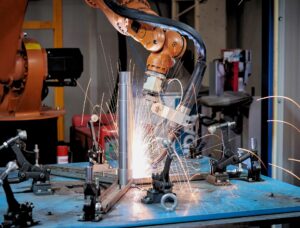Welding gases play a crucial role in achieving high-quality welds by protecting the weld pool from atmospheric contamination and influencing the overall welding process. Understanding the different types of welding gases, their uses, and safety precautions is essential for professional welders and manufacturers alike. This guide explores the most common welding gases like argon, carbon dioxide (CO₂), and oxygen, their applications, and how Mecaweld’s welding cameras help ensure safe and precise welding operations.
What Are Welding Gases?
Welding gases are used for shielding, purging, and cutting in various welding processes. These gases can be classified into two main categories:
- Inert Gases: Non-reactive gases like argon and helium that prevent oxidation and contamination.
- Active Gases: Reactive gases like CO₂ and oxygen that enhance penetration and arc stability.
Selecting the right welding gas depends on factors such as material type, welding process, and desired weld characteristics.
Common Types of Welding Gases and Their Applications
1. Argon (Ar)
- Uses:
- Primary shielding gas for TIG and MIG welding
- Ideal for aluminum, stainless steel, and titanium welding
- Provides smooth, stable arcs and clean welds
- Advantages:
- Prevents oxidation and contamination
- Produces aesthetically pleasing welds with minimal spatter
- How Mecaweld Helps:
- Mecaweld welding cameras allow welders to monitor the argon shielding process in real-time, ensuring complete gas coverage and preventing weld defects.
2. Carbon Dioxide (CO₂)
- Uses:
- Common shielding gas for MIG welding (either pure or mixed with argon)
- Used in structural welding and fabrication
- Enhances penetration and arc stability
- Advantages:
- More affordable than inert gases
- Suitable for thick steel welding
- How Mecaweld Helps:
- Welding cameras detect inconsistencies in gas shielding, reducing porosity and spatter.
3. Oxygen (O₂)
- Uses:
- Added in small amounts to welding gas mixtures to enhance arc performance
- Improves penetration and bead shape in stainless steel and carbon steel welding
- Advantages:
- Increases fluidity of the weld pool
- Enhances cutting efficiency in oxy-fuel welding
- Precaution:
- Excess oxygen can lead to excessive oxidation and brittleness.
- How Mecaweld Helps:
- Real-time monitoring ensures proper oxygen levels, preventing oxidation-related defects.
4. Helium (He)
- Uses:
- Used in TIG and MIG welding for aluminum, copper, and stainless steel
- Mixed with argon for increased heat input
- Advantages:
- Provides deep penetration and high travel speeds
- Suitable for thick materials
- How Mecaweld Helps:
- Helps optimize helium shielding, ensuring weld integrity and minimizing distortion.
5. Acetylene (C₂H₂)
- Uses:
- Primary fuel gas for oxy-acetylene welding and cutting
- Used for brazing and flame-hardening
- Advantages:
- Produces the highest flame temperature (over 3,000°C)
- Suitable for portable welding applications
- How Mecaweld Helps:
- Detects inconsistencies in flame settings, optimizing heat control for precise welding.
Welding Gas Safety Best Practices
Handling welding gases requires strict safety precautions to prevent accidents, gas leaks, and exposure risks.
Proper Storage:
- Keep gas cylinders upright and secured.
- Store flammable gases separately from oxidizers.
- Avoid direct sunlight and heat sources.
Gas Cylinder Handling:
- Use proper regulators and fittings for each gas type.
- Never force connections or modify cylinders.
- Check for leaks using soapy water before welding.
Ventilation and Protection:
- Work in well-ventilated areas to prevent gas buildup.
- Wear appropriate PPE, including gloves and face shields.
Fire Prevention:
- Keep flammable materials away from welding areas.
- Have fire extinguishers readily available.
Using Mecaweld Welding Cameras for Safety:
- Mecaweld’s welding cameras help detect irregular gas flow, preventing welding defects caused by poor shielding.
- Live weld monitoring improves precision and minimizes the risk of gas-related welding flaws.
Choosing the Right Welding Gas for Your Application
Different welding projects require specific gas combinations for optimal results.
| Material | Recommended Gas | Welding Process |
| Carbon Steel | CO₂, Argon + CO₂ | MIG, FCAW |
| Stainless Steel | Argon + O₂, Argon + CO₂ | MIG, TIG |
| Aluminum | Pure Argon, Argon + Helium | MIG, TIG |
| Copper & Brass | Argon + Helium | TIG |
Mecaweld’s advanced welding camera technology allows welders to fine-tune their gas flow in real-time, reducing waste and optimizing welding quality.
Conclusion: The Most Common Welding Gases
Understanding welding gases is essential for achieving strong, clean welds while ensuring safety and efficiency. Whether using argon for precision TIG welding or CO₂ for high-penetration MIG welding, selecting the right gas can make a significant difference. Mecaweld’s welding cameras provide real-time gas shielding analysis, helping welders achieve defect-free, high-quality welds while enhancing workplace safety.🚀
Optimize your welding process with Mecaweld! Contact us today to learn more about our innovative welding monitoring solutions.



